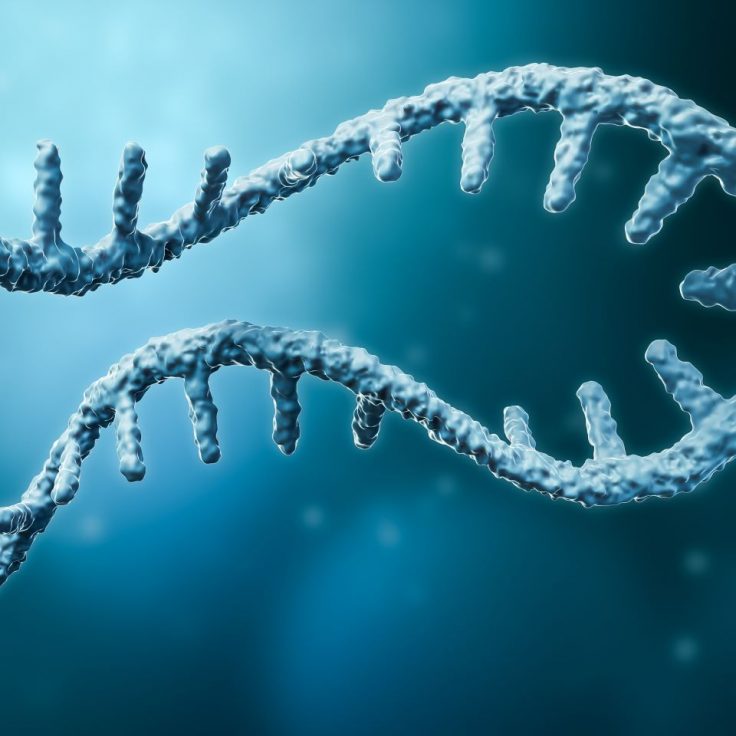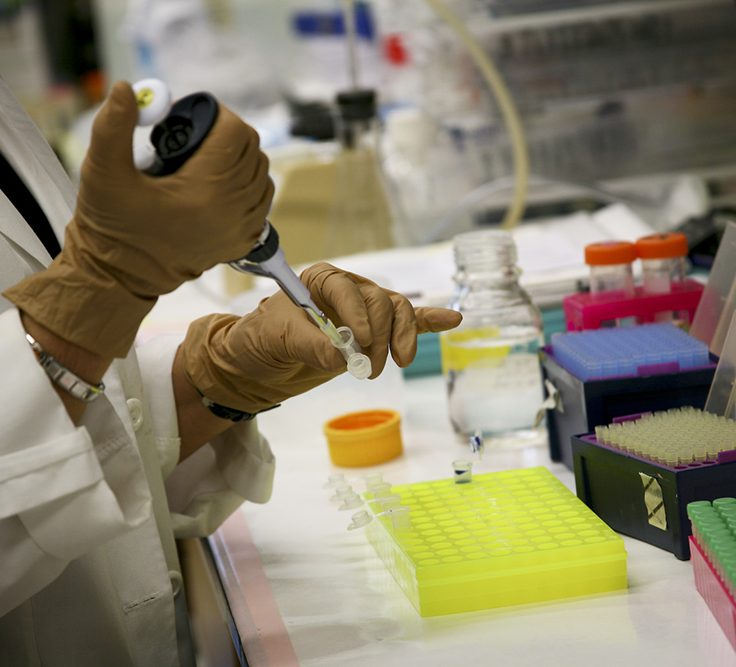
A New Experiment
On an emptier campus, chemistry labs are bustling as they adjust to new measures
When the COVID-19 pandemic’s arrival in Florida forced chemistry laboratories to close their doors in March, the department’s faculty, staff and students were overwhelmed by questions.
How would the over 3,000 students enrolled in lab classes continue their studies? How would researchers continue their essential work? How could the spaces be adapted to ensure safety for all?
Six months later, the labs are consistently abuzz with students — albeit with many changes. With more than 2,000 students currently taking a chemistry lab course with an in-person component, the facilities have settled into a rhythm with reduced capacities, social distancing and increased safety precautions.
The differences are immediately noticeable in the Chemistry/Chemical Biology building’s first-floor general chemistry lab, where students, all with masks on and the recommended space between them, spread out among the 16 work stations in each of the four bays as they performed acid-base tests.
“I’ve never felt unsafe,” Kyle Bisson, a sophomore chemistry major, said while in the lab on a recent Tuesday afternoon. He was eager to return after the spring’s shift to online, video-based classes. “It’s fun to play around in the lab, and you’re gaining practical abilities.”
Instead of the usual eight students packing each lab bench — as many as 256 students in a full class — they’re now limited to two per bench. To accommodate the necessary distancing, the General Chemistry 2 lab has expanded in the space of the General Chemistry 1 lab, which was moved online. The course is spread out into multiple sections stretching from midday Monday to early evening Thursday. Each student now works solo instead of with a partner.
“They have to do more themselves. No free-riders,” lab manager Candace Biggerstaff joked.
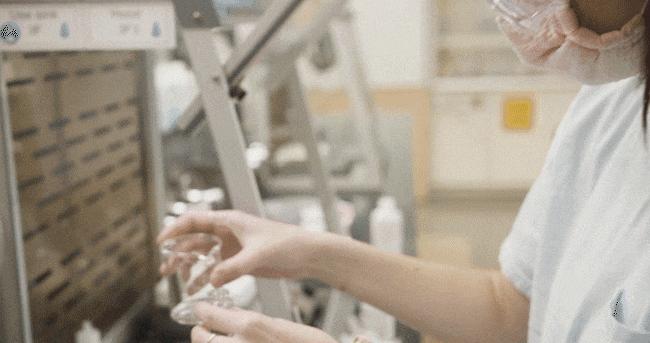
That’s not the only consequence of each student working alone: It also drastically increases the workload for those running the labs. Twice as many kits have to be prepared by lab managers and lab specialists, and teaching assistants have a much larger footprint to cover in each section as they aid students. The transition has been a heavy lift, but the result is worth it, lab staff said.
“It means a lot to be here in person,” said Jessica Webb, a lab specialist. “The students understand more with face to face interaction. I can point things out and guide them in a more direct way.”
The department’s lab classes shifted to online learning through the late spring and summer, filming demonstrations and meeting with students over Zoom. One general chemistry lab course still takes place entirely online, and recorded versions of the in-person sessions are available for those who have to miss a meeting to quarantine. These options are vital to coping with the present public health crisis, but the opportunity to be in the lab offers unique advantages.
“Without the knowledge of the equipment, it’s not the same experience,” Biggerstaff said. “Here, they’re actually collecting their own data to work with.”
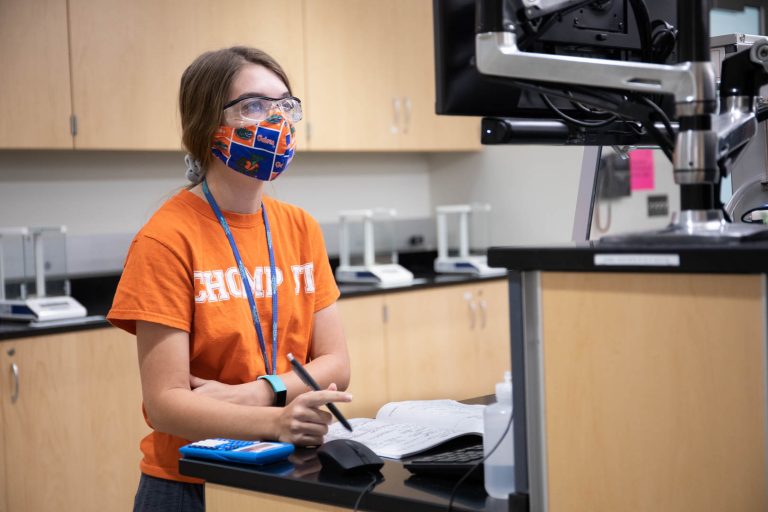
Upstairs in the organic chemistry lab, the room allows a half capacity of about 50 students. Just outside in the hallway, stanchions are set so the door can be left open, which allows air circulation and reduces touchpoints while still preventing foot traffic from wandering in.
Kiara Xhindi, a biomedical engineering student, said the only downside she’s seen has been the occasional fogging of goggles due to having to wear face masks.
“It gives you opportunities to see how the theory applies to practice,” Xhindi said. “To me, it’s really exciting, and I’m actually really happy we get the opportunity to come in.”
The class meeting here comes into the lab for one session each week and then spends the other session on Zoom. Lab manager Joshua Bush said he’s been impressed by how the students have adjusted to new safety guidelines.
“I’ve never had to talk to anybody about their masks,” he said. “It’s really been amazing to see the students reacting to the conditions that we’re in. I think all of these students really want to be here.”
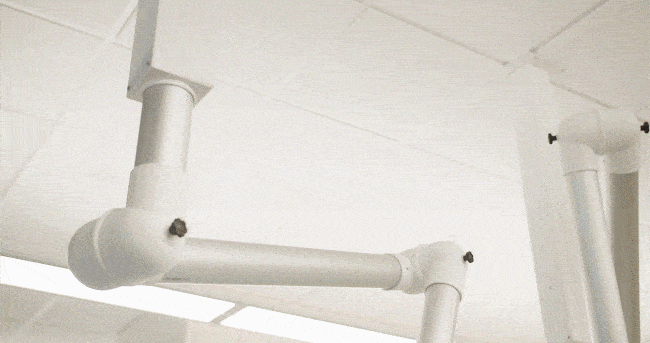
The changes haven’t only had an impact on large lab classes. For graduate students who need to conduct research to make progress on their dissertations, the prospect of labs shutting down was unnerving.
Before the pandemic, chemistry Ph.D. candidate Stephen Sangster practically lived in the lab between his own research and his time as a teaching assistant. As summer approached, he expected to take advantage of a reduced class load to dive deeper into his studies of sustainable polymers as part of a research group led by Professor Stephen A. Miller. The pandemic, and ensuing lab closures, upended those plans.
“Would it delay the results I needed to get enough research body of work within the 5 years?” Sangster said he wondered at the time. “I felt like I was losing a major period of time where I could push forward my research to where it needed to be for my second year. That was the challenge.”
From March through May, he continued to meet with his group, review research papers and conduct computational research that could be done remotely, keeping his scientific mind sharp. Eventually, the itch to get back into their research lab in Sisler Hall became overwhelming.
When he and his fellow graduate students got clearance to return at the beginning of June, space was the immediate concern. While they used to work in constant close proximity, they were now rotating in shifts — which, it turned out, had its silver linings. Sangster, who was going into his second year, could no longer lean on the knowledge of his more experienced groupmates.
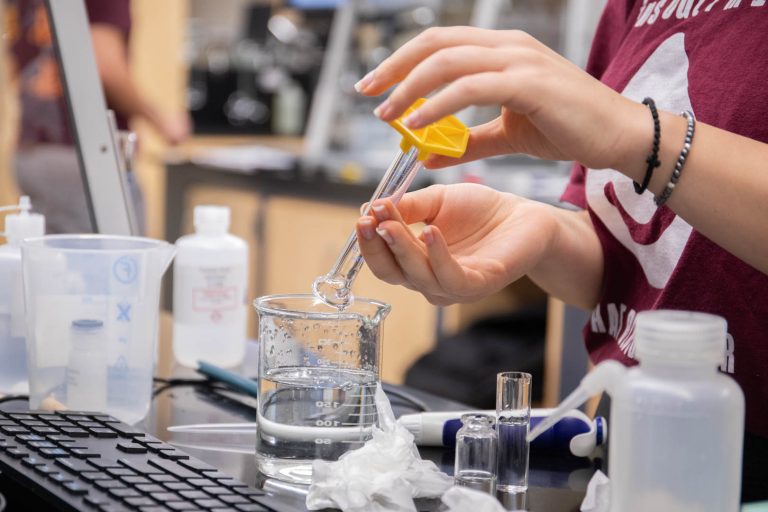
“Alone, I had to be more methodical, and think things through beforehand,” he said. “Because we only had a specific shift, time was very valuable. We had to be very efficient, and I think that’s carried over to now, even as restrictions have loosened.”
As for safety and hygiene guidelines, not much changed — they were already in the habit of washing hands and cleaning items. The only difference were the masks. Throughout the experience, Sangster said his professors have been accommodating.
“They’ve allowed things to develop as people feel more comfortable,” he said. In Sangster’s case, not much encouragement was required. “I was just happy to be getting back to research,” he said. “Absence makes the heart grow fonder.”
Looking ahead to next semester, changes are on the horizon. The department expects to have about 500 more students in its labs as the college and university significantly increase in-person classes in the spring 2021 semester.
“The spring will be a new challenge, but if things continue as they’ve been going, it will progress in a positive way,” said Alexander Angerhofer, a professor and associate chair of the department. “I can tell everyone has been taking it seriously.”
